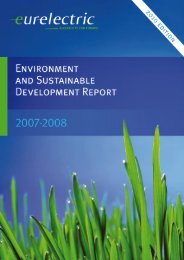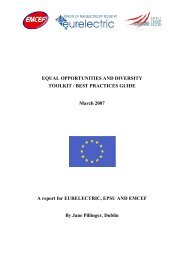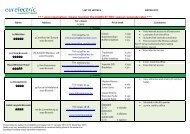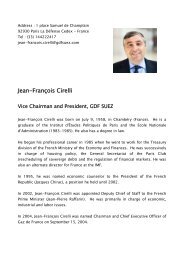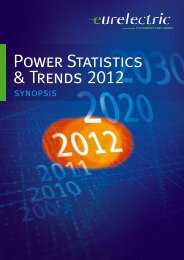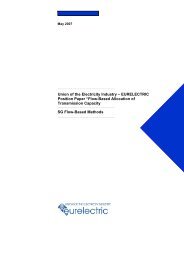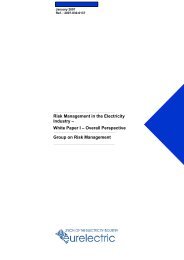Letter addressed to: Environment Ministers Energy ... - Eurelectric
Letter addressed to: Environment Ministers Energy ... - Eurelectric
Letter addressed to: Environment Ministers Energy ... - Eurelectric
You also want an ePaper? Increase the reach of your titles
YUMPU automatically turns print PDFs into web optimized ePapers that Google loves.
<strong>Letter</strong> <strong>addressed</strong> <strong>to</strong>:<br />
<strong>Environment</strong> <strong>Ministers</strong><br />
<strong>Energy</strong> <strong>Ministers</strong><br />
Brussels, 17 April 2013<br />
Subject: Impact of electrification of transport and heating on air quality<br />
Dear Minister,<br />
We write regarding the review of the EU Air Quality Policy and the important role electricity has <strong>to</strong><br />
play in the improvement of air quality and health in Europe. Electricity has no emissions at the<br />
point of use and, when used in transport and heating/cooling for instance, can significantly<br />
contribute <strong>to</strong> improving air quality in cities and urban areas.<br />
The electricity sec<strong>to</strong>r has significantly reduced its emissions over the years. Between 1980 and<br />
2009 emissions of SO₂ and NOx were reduced in the EU-27 by around 80% and 57% respectively,<br />
while electricity demand grew by 75%. The implementation of the EU environmental legislation<br />
and the move <strong>to</strong> a decarbonised power sec<strong>to</strong>r will lead <strong>to</strong> a further decline in emissions from the<br />
power sec<strong>to</strong>r. Furthermore the decoupling of electricity generation and emissions means that the<br />
emissions per unit of electricity generated will decline steadily.<br />
The EU electricity sec<strong>to</strong>r is strongly committed <strong>to</strong> reducing carbon emissions and meeting the EU's<br />
climate targets for 2020 and its 2050 climate vision. We are also convinced that electricity will<br />
have <strong>to</strong> play a much greater role than now <strong>to</strong> contribute <strong>to</strong> the decarbonisation of transport and<br />
heating/cooling. This is confirmed by the Commission's <strong>Energy</strong> Roadmap 2050 and the European<br />
<strong>Environment</strong> Agency. EURELECTRIC believes that 2013, the 'Year of Air', is a unique opportunity <strong>to</strong><br />
show that electricity brings wider benefits in helping the shift <strong>to</strong>wards sustainable transport and<br />
residential sec<strong>to</strong>rs: it can not only help <strong>to</strong> de-carbonise others sec<strong>to</strong>rs, it can also help <strong>to</strong> depollute<br />
them.<br />
EURELECTRIC welcomes the opening of the debates on the EU's policy instruments beyond 2020<br />
both for climate and energy and air quality. Clarity on the 2030 framework and, in particular, on a<br />
CO₂ reduction target are urgently needed <strong>to</strong> ensure that electricity companies can invest <strong>to</strong> put<br />
the sec<strong>to</strong>r on track for Europe's transition <strong>to</strong>wards a low-carbon energy system. It is crucial that<br />
developments in EU Air Quality policy are assessed in a framework which is consistent with EU<br />
energy and climate policy developments. For these reasons, 2030 is a more appropriate date for<br />
more ambitious emission ceilings as by this date it is expected that the power sec<strong>to</strong>r across<br />
Europe will be significantly decarbonised (with co-benefits for air quality emissions).<br />
Union of the Electricity Industry - EURELECTRIC AISBL . Boulevard de l’Impératrice, 66 - bte 2 . B - 1000 Brussels . Belgium<br />
Tel: + 32 2 515 10 00 . Fax: + 32 2 515 10 10 . VAT: BE 0462 679 112 . www.eurelectric.org<br />
1/2
In this context, we welcome initiatives such as the recent proposals on clean transport fuels and<br />
the expected urban mobility package. However, we would like <strong>to</strong> stress that the current<br />
legislative framework still promotes the direct use of carbon-emitting fuels such as petrol or gas in<br />
heating ahead of electricity, contradicting the direction set in the 2050 <strong>Energy</strong> Roadmap. The<br />
persistent use of a 2.5 energy efficiency conversion fac<strong>to</strong>r for electricity in the EU legislation,<br />
established before climate change became an issue and carbon reduction targets were developed,<br />
does not reflect the evolution of the electricity mix. It results in a lock-in of fossil fuel solutions for<br />
a considerable period and prevents EU citizens benefiting from electrification. Taxation should<br />
also be aligned with Europe sustainability goals. The legislative framework should ensure that<br />
electrification can contribute <strong>to</strong> the achievement of policy objectives aimed at reducing CO₂, NO₂<br />
(transport/diesel in urban centres) and PM10 (coal/solid fuels for residential heating) emissions in<br />
particular. You will find in Annex references <strong>to</strong> the main texts which could support electrification<br />
goals.<br />
Looking forward <strong>to</strong> your reaction and happy <strong>to</strong> respond <strong>to</strong> any questions or comments you may<br />
have.<br />
Encl : 1 Annex<br />
Best regards,<br />
Hans ten BERGE<br />
Secretary General<br />
Union of the Electricity Industry - EURELECTRIC AISBL . Boulevard de l’Impératrice, 66 - bte 2 . B - 1000 Brussels . Belgium<br />
Tel: + 32 2 515 10 00 . Fax: + 32 2 515 10 10 . VAT: BE 0462 679 112 . www.eurelectric.org<br />
2/2
Annex<br />
Directive 2012/27/EU on energy efficiency and repealing Directives 2004/8/EC<br />
(cogeneration) and 2006/32/EC (energy end-use efficiency and energy services)<br />
The recently revised directive has kept the primary energy conversion fac<strong>to</strong>r introduced in a<br />
footnote <strong>to</strong> Annex II of the now repealed Directive 2006/32/EC on energy end‐use efficiency<br />
and energy services (<strong>Energy</strong> Services Directive) as a suggestion for Member States who “[f] or<br />
savings in kWh electricity (…) may apply a default co‐efficient of 2.5 reflecting the estimated<br />
40% average EU generation efficiency (…)”.This would mean that 2.5 kWh of primary energy is<br />
needed <strong>to</strong> generate 1 kWh of electricity. However, as the efficiency of power stations<br />
improves and the proportion of electricity from renewable sources increases, the average<br />
conversion fac<strong>to</strong>r is in reality reduced overtime.<br />
This energy efficiency metric is an his<strong>to</strong>ric concept derived from oil crises of last century when<br />
oil represented 27% of OECD generation (1973) as opposed <strong>to</strong> 2% <strong>to</strong>day (2010) and from a<br />
time where the challenges of climate change were not an issue at all. It assumes all forms of<br />
energy are equal, i.e. 1kWh lignite = 1 kWh PV, and the carbon constraint is ignored. This<br />
reliance on a static, his<strong>to</strong>ric looking timeframe leads <strong>to</strong> anomalies in the treatment of<br />
electricity and even more seriously – it locks in CO₂ and air pollutants-emitting technologies.<br />
To reach the challenging targets for greenhouse gases and air pollutants emissions, energy<br />
end-use must be based on CO₂-free energy carriers such as electricity. Fossil fuels should be<br />
concentrated in large plants where carbon capture and s<strong>to</strong>rage can be applied.<br />
Directive 2010/31/EU of 19 May 2010 on the <strong>Energy</strong> Performance of Buildings (EPBD)<br />
The EPBD requires that Member States define a primary energy conversion fac<strong>to</strong>r for<br />
electricity, <strong>to</strong> be used in assessing a building’s calculated energy performance against the<br />
standards set. The Directive overemphasises primary energy efficiency without any<br />
consideration of the interaction with other energy and environmental policy objectives. This<br />
will seriously inhibit the substitution of electricity for fossil fuel use in heating and contribute<br />
<strong>to</strong> lock-in CO₂ and air pollutants emissions for energy end-use for the lifecycle of the building.<br />
Emphasis on primary energy is confirmed in supplementing Regulation (EU) n°244/2012<br />
establishing a comparative methodology framework for calculating cost-optimal levels of<br />
minimum energy performance requirements for buildings and building elements, and its<br />
accompanying guidelines.<br />
Directive 2009/125/EC establishing a framework for the setting of Eco design requirements<br />
for energy‐related products<br />
Directive 2010/30/EU on the indication by labelling and standard product information of the<br />
consumption of energy and other resources by energy-related products<br />
Union of the Electricity Industry - EURELECTRIC AISBL . Boulevard de l’Impératrice, 66 - bte 2 . B - 1000 Brussels . Belgium<br />
Tel: + 32 2 515 10 00 . Fax: + 32 2 515 10 10 . VAT: BE 0462 679 112 . www.eurelectric.org
This is illustrated by the latest texts adopted on space and water heaters. When a single scale<br />
is used for appliances which may be powered either by electricity or by alternative energies,<br />
the use of a primary conversion fac<strong>to</strong>r of 2.5 discriminates against the use of electric<br />
appliances, as their efficiency is deemed, in effect, <strong>to</strong> be no more than 40%. While the<br />
maximum output efficiency of electric water heaters is deemed not <strong>to</strong> exceed 40%, the least<br />
efficient domestic hot water boilers are deemed <strong>to</strong> have a minimum of 70%. This introduces<br />
discrimination between appliances and energy sources and locks in CO₂ and air pollutants<br />
emissions for the life-cycle of the product. This is particularly detrimental as electrical<br />
appliances, and water heaters in particular, are the most cost‐effective way <strong>to</strong> integrate<br />
electricity generated from renewable sources through developing controllable demand‐side<br />
measures which can adapt instantaneous demand <strong>to</strong> the fluctuating supply that is typical of<br />
renewable sources such as wind.<br />
Proposal for a Council Directive amending Directive 2003/96/EC restructuring the<br />
Community framework for the taxation of energy products and electricity COM (2011) 169<br />
EURELECTRIC welcomed this initiative, in particular the introduction of a CO₂ tax for the non-<br />
ETS sec<strong>to</strong>rs which would contribute <strong>to</strong> a level playing field and <strong>to</strong> an overall least cost<br />
approach <strong>to</strong> reducing CO₂ emissions. EURELECTRIC supports linking the CO₂ component <strong>to</strong> the<br />
ETS carbon price and au<strong>to</strong>matically adjust it on a regular basis (e.g. annually) <strong>to</strong> reflect the<br />
development of the carbon price. We also support the "proportionality principle" foreseen in<br />
the initial proposal and urge policymakers <strong>to</strong> ensure that negotiations do not lead <strong>to</strong> a<br />
discrimination against the use of electricity in heating and transport, e.g. in the form of heat<br />
pumps or electric vehicles.



